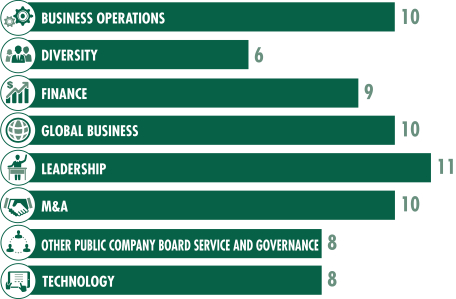Notwithstanding the foregoing, the Board shall constitute the Committee and
shall administer the Plan with respect to all Awards granted to Non-Employee Directors.
(b) Authority of the Committee. Subject to the provisions of the Plan, the Committee shall have full authority and
discretion to take any actions it deems necessary or advisable for the administration of the Plan. Such actions shall include without limitation:
(i) determining Participants who are to receive Awards under the Plan;
(ii) determining the type, number, vesting requirements, Performance Criteria (or other objective/subjective
goals (if any)) and their degree of satisfaction, and other features and conditions of such Awards and amending such Awards;
(iii) correcting any defect, supplying any omission, or reconciling or clarifying any inconsistency in the Plan
or any Award Agreement;
(iv) accelerating the vesting or extending the post-termination exercise term, or
waiving restrictions, of Awards at any time and under such terms and conditions as it deems appropriate;
(v) permitting or denying, in its discretion, a Participant’s request to transfer an Award;
(vi) permitting or requiring, in its discretion, a Participant to use Cashless Exercise, Net Exercise and/or
Share withholding with respect to the payment of any Exercise Price and/or applicable tax withholding;
(vii) interpreting the Plan and any Award Agreements;
(viii) making all other decisions relating to the operation of the Plan; and
(ix) granting Awards to Participants who are foreign nationals on such terms and conditions different from
those specified in the Plan, which may be necessary or desirable to foster and promote achievement of the purposes of the Plan, and adopting such modifications, procedures, and/or subplans (with any such subplans attached as appendices to the Plan)
and the like as may be necessary or desirable to comply with provisions of the laws or regulations of other countries or jurisdictions to ensure the viability of the benefits from Awards granted to Participants employed in such countries or
jurisdictions, or to meet the requirements that permit the Plan to operate in a qualified or tax efficient manner, and/or comply with applicable foreign laws or regulations.
The Committee may adopt such rules or guidelines, as it deems appropriate to implement the Plan. The Committee’s
determinations under the Plan shall be final, conclusive and binding on all persons. The Committee’s decisions and determinations need not be uniform and may be made selectively among Participants in the Committee’s sole discretion. The
Committee’s decisions and determinations will be afforded the maximum deference provided by applicable law.
(c)
Indemnification. To the maximum extent permitted by applicable law, each member of the Committee, or of the Board, or any persons (including without limitation Employees and Officers) who are delegated by the Board or Committee to perform
administrative functions in connection with the Plan, shall be indemnified and held harmless by the Company against and from (i) any loss, cost, liability or expense that may be imposed upon or reasonably incurred by him or her in connection
with or resulting from any claim, action, suit or proceeding to which he or she may be a party or in which he or she may be involved by reason of any action taken or failure to act under the Plan or any Award Agreement, and (ii) from any and
all amounts paid by him or her in settlement thereof, with the Company’s approval, or paid by him or her in satisfaction of any judgment in any such claim, action, suit or proceeding against him or her; provided, that he or she shall
give the Company an opportunity, at its own expense, to handle and defend the same before he or she undertakes to handle and defend it on his or her own behalf. The foregoing right of indemnification shall not be exclusive of any other rights of
indemnification to which such persons may be entitled under the Company’s Certificate of Incorporation or Bylaws, by contract, as a matter of law, or otherwise, or under any power that the Company may have to indemnify them or hold them
harmless.
SECTION 4. GENERAL.
(a) General Eligibility. Only Employees, Consultants and Non-Employee Directors
shall be eligible for designation as Participants by the Committee.
(b) Incentive Stock Options. Only Participants
who are common-law employees of the Company, a Parent or a Subsidiary shall be eligible for the grant of ISOs. In addition, a Participant who is a 10-Percent Shareholder
shall not be eligible for the grant of an ISO unless the requirements set forth in Code Section 422(c)(5) are satisfied. If and to the extent that any Shares are issued under a portion of any Option that exceeds the $100,000 limitation of Code
Section 422, such Shares shall not be treated as issued under an ISO notwithstanding any designation otherwise. Certain decisions, amendments, interpretations and actions by the Company or the Committee and certain actions by a Participant may
cause an Option to cease to qualify as an ISO pursuant to the Code and by accepting an Award of Options, a Participant agrees in advance to such disqualifying action(s).
(c) Restrictions on Shares. Any Shares issued pursuant to an Award shall be subject to such Company policies, rights of
repurchase, rights of first refusal and other transfer restrictions as the Committee may determine. Such restrictions shall apply
|
|
|
| B-6 |
|
CBRE - 2019 Proxy Statement |









 CEO + NEOS TARGET COMPENSATION MIX
CEO + NEOS TARGET COMPENSATION MIX 
